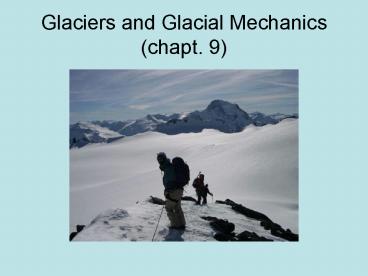Glaciers and Glacial Mechanics chapt' 9
1 / 42
Title: Glaciers and Glacial Mechanics chapt' 9
1
Glaciers and Glacial Mechanics(chapt. 9)
2
Is this a glacier?
3
Glacier definition
- A glacier is a MOVING body of ICE that has been
formed on land by the COMPACTION and
RECRYSTALIZATION of SNOW
4
Water in the hydrosphere
- Oceans 97.2
- Ice sheets and glaciers 2.18
- Groundwater 0.6
- Lakes and streams 0.018
- Soil moisture 0.005
- Atmosphere 0.001
- 99 of water is UNAVAILABLE to us
5
When do glaciers form?
6
When do glaciers form?
- Glaciers form when the amount of snow falling in
the winter is greater than the amount that melts
in the summer
7
Milankovitch proposed that ice sheets grow in the
northern hemisphere when tilt is low, and summer
solstice occurs at aphelion
8
Milankovitch theory orbital variations produces
changes in insulation
Last Glacial Maximum 21,000 years ago
9
Records of climate change preserved in ice core
records
10
Records of climate change preserved in ice
11
Records of climate change preserved in ice
12
North America 21,000 years ago
13
How do glaciers form?
- Part 1 changing snow to ice
- Snow becomes denser with time and compaction
- New snow density (0.05 g/cm3), FIRN (old snow)
density 0.55 g/cm3 - Burial, pressure, and refreezing of meltwater
leads to increase in crystal size - As crystal sizes grow and spaces around snow and
ice crystals disappear density increases - Density increases to 0.85-0.9 g/cm3ice!
14
Metamorphism of snow into ice (still preserve
annual layers!)
15
Now we have icewhats next?
16
How do glaciers grow? Glacial Mass Balance
17
Glacier mass balance
18
Glacier mass balance
- Accumulation addition of snow and ice to a
glacier - Ablation processes that remove snow and ice
- Melting, sublimation, calving
19
(No Transcript)
20
How do glaciers grow? Glacial Mass Balance
- the Equilibrium Line Altitude (ELA) is the
elevation on the glacier where the volumes of
accumulation and ablation are equal (Balance
point) - This is also the long-term average position of
the highest (late summer) firn line. - The ELA is climate and location dependent
- In a small glacier, 66 of the glacial area is
the accumulation area, and 33 is the ablation
area. Why? Need larger area to accumulate snow
in order to equal the amount that is melting below
21
How do glaciers grow? Glacial Mass Balance
Border between old dirty snow and ice and new
snow firn line
22
Accumulation and ablation
23
(No Transcript)
24
How do glaciers move?
25
Now we have icewhats next?
- ppgh
- pressuredensitygravityheight (thickness of
ice) - What does this mean? Pressure has an influence
on the freezing point.
26
How do glaciers move?
- Glaciers move via 2 processes
- Internal deformation of the ice (creep)
- Sliding of the glacier on its base
- Glacial movement pseudoplastic
plastic
stress
Strain rate
27
How do glaciers move?
- Internal flow
- Ice crystals move by creep along internal planes
- Like deck of cards being pushed
28
How do glaciers move?
- Internal flow
- Ice crystals move by creep along internal planes
- Like deck of cards being pushed
- Shear stresspgh -gt greatest stress at base of
glacier
29
Glacial movement-velocity profiles
- Similar concept to stream velocity
- Friction reduces velocity on sides of glacier
- Velocity at surface is the TOTAL of all the
layers beneath - Fastest velocity at surface of glacier (even
though shear stress is greatest at base) - Each layer is carried on top of the layer beneath
30
Where is flow velocity greatest on a glacier?
Near the equilibrium line-highest ice discharge
in that area
31
Velocity profile on glaciers
32
How do glaciers move?
- Internal flow
- Ice crystals move by creep along internal planes
- Like deck of cards being pushed
- Basal sliding
- Melt water at base of glacier allows glacier to
slide along its base - Depends on temperature
- Regelation slip (melting and refreezing over
obstacles)
33
Regelation slip
34
- http//www.homepage.montana.edu/geol445/hyperglac
/systems1/
35
Major types of glaciers (morphological
classification)
- Cirque glaciers
- Mountain glaciers
- Form in amphitheater-shaped depressions (called
cirques!) - Size-few kilometers
- Valley glaciers
- Streams of ice that flow downvalley from a cirque
- 100s of km
- Piedmont glaciers
- Glaciers that discharge ice from mountains onto
broad lowlands - Ice becomes unconfined
- Ice sheets
- Bread ice masses not confined to valleys, massive
thicknesses of ice - 1000s of km
- Creates its own topography, creates isostatic
depression
36
Cirque glacier
37
valley glacier
38
Valley glacier
39
Ice sheet
40
Wet based (temparate) vs. cold based (polar)
glaciers
- Wet-based or temperate glaciers
- Glaciers at pressure melting point that slide on
a layer of liquid water (large component of basal
sliding) - Lots of meltwater, higher velocities, more
erosion - Cold-based or polar glaciers
- Glaciers are stuck to their bed. These glaciers
are characteristic of cold, polar areas. - No meltwater, minimal slippage along base, lower
velocity, less erosion, less geomorphic work
41
How do glaciers move material?
- (Glaciers dont bulldoze! )
- Glaciers are more like conveyor belts. Glacial
deposits mark where a glacier has been in the
same place for a period of time. - Except glaciers can construct minor push
moraines. MOST material is transported within
and on top of the glacier
42
(No Transcript)































